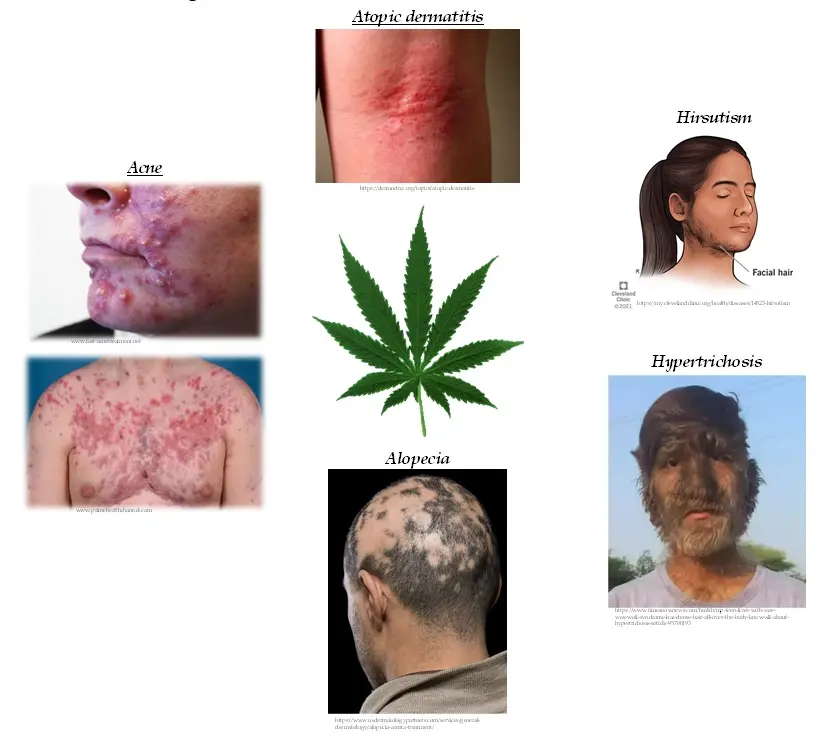Who are we?
Staff
Head: Dr. Attila Oláh, MD, PhD, associate professor
Dr. Erika Lisztes, PhD, research fellow
Ádám Dorottya, MSc, assistant research fellow
József Arany, MSc, assistant research fellow
Mónika Barotáné Kovács, laboratory assistant
Former members:
Dr. Ágnes Angyal, MSc, PhD
Dr. Kinga Fanni Volascsekné Tóth, MSc, PhD
What are we doing?

Figure 1 Major research interest of the Cannabinoid Research Group: experimental dermatology
Research profile
Complex cannabinoid signaling (Figure 2) contributes to the regulation of a number of (patho)physiological processes in human skin. These include, but are not limited to, local inflammatory processes, sebum production, pigmentation, hair growth, or differentiation of epidermal keratinocytes. Dysregulation of these processes play an important role in the pathogenesis of highly prevalent diseases (e.g., acne, hair growth disorders, atopic dermatitis, etc.). Thus, together with national and international collaborators, and industrial partners, our team aims to explore the putative therapeutic potential of the cannabinoid signaling in the above diseases.

Figure 2 Overview of the complex cannabinoid signaling (Tóth et al., Molecules, 2019)
We mostly use molecular and cellular physiology approaches. In addition to the “endogenous” cannabinoids produced in our body, we also study the effects of plant-derived cannabinoids and “cannabinoid-like” compounds, as well as signaling systems that are related to the cannabinoid signaling (e.g., purinergic signaling, TRP channels, etc.). Moreover, we plan to pay special attention to the interactions between the cannabinoid signaling and the extracellular vesicle-mediated intercellular communication.
In our experiments, we investigate cell lines, primary human cells, reconstructed skin equivalents, as well as various organ cultures (e.g., hair follicle, full-thickness human skin). Among others, changes in viability, proliferation, lipid production, intracellular ion homeostasis, gene expression (Q-PCR, western blot, immunolabeling), and mediator production (ELISA) are monitored. We influence gene expression by various methods (e.g., siRNA-mediated selective gene silencing), while in the case of genomic and lipidomic studies, we rely on the expertise of our collaborators (Figure 3).

Figure 3 Overview of the methodical repertoire of the Cannabinoid Research Group
Current research topics:
- Role of the cannabinoid and the purinergic signaling, as well as of TRPM channels in acne
- Mitochondrial biology aspects of the pathogenesis of acne
- Role of the extracellular vesicle (EV)-mediated intercellular communication in acne
Selected publications:
- Oláh A, Tóth BI, Borbíró I, Sugawara K, Szöllősi AG, Czifra G, Pál B, Ambrus L, Kloepper J, Camera E, Ludovici M, Picardo M, Voets T, Zouboulis CC, Paus R, Bíró T (2014) Cannabidiol exerts sebostatic and antiinflammatory effects on human sebocytes. J. Clin. Invest. 124(9):3713-3724. doi: 10.1172/JCI64628. IF: 13.262; Medicine (miscellaneous): D1.
- Oláh A, Ambrus L, Nicolussi S, Gertsch J, Tubak V, Kemény L, Soeberdt M, Abels C, Bíró T (2016) Inhibition of fatty acid amide hydrolase exerts cutaneous anti-inflammatory effects both in vitro and in vivo. Exp. Dermatol. 25(4):328-330. doi: 10.1111/exd.12930. IF: 2.532; Dermatology: D1.
- Oláh A#, Markovics A#, Szabó-Papp J, Szabó PT, Stott C, Zouboulis CC, Bíró T (2016) Differential effectiveness of selected non-psychotropic phytocannabinoids on human sebocyte functions implicates their introduction in dry / seborrheic skin and acne treatment. Exp. Dermatol. 25(9):701-707. doi: 10.1111/exd.13042. #Shared first authorship. IF: 2.532; Dermatology: D1.
- Zákány N#, Oláh A#, Markovics A, Takács E, Aranyász A, Nicolussi S, Piscitelli F, Allarà M, Pór Á, Kovács I, Zouboulis CC, Gertsch J, Di Marzo V, Bíró T, Szabó T (2018) Endocannabinoid tone regulates human sebocyte biology. J. Invest. Dermatol. 138(8):1699-1706. doi: 10.1016/j.jid.2018.02.022. IF: 6.290; Dermatology: D1. #Shared first authorship.
- Szántó M#, Oláh A#, Szöllősi AG, Tóth KF, Páyer E, Czakó N, Pór Á, Kovács I, Zouboulis CC, Kemény L, Bíró T, Tóth BI (2019) Activation of TRPV3 inhibits lipogenesis and stimulates production of inflammatory mediators in human sebocytes – a putative contributor to dry skin dermatoses. J. Invest. Dermatol. 139(1):250-253. doi: 10.1016/j.jid.2018.07.015. IF: 7.143; Dermatology: D1. #Shared first authorship.
- Tóth KF, Ádám D, Bíró T#, Oláh A#,& (2019) Cannabinoid signaling in the skin: Therapeutic potential of the “c(ut)annabinoid” system. Molecules 24:918. doi: 10.3390/molecules24050918. IF: 3.267; Pharmaceutical Science: Q1. #Shared last authorship. &Corresponding author.
- Markovics A, Tóth KF, Sós KE, Magi J, Gyöngyösi A, Benyó Z, Zouboulis CC, Bíró T#, Oláh A# (2019) Nicotinic acid suppresses sebaceous lipogenesis of human sebocytes via activating hydroxycarboxylic acid receptor 2 (HCA2). J. Cell. Mol. Med. 23(9):6203-6214. doi: 10.1111/jcmm.14505. IF: 4.486; Molecular Medicine: Q1. #Shared last authorship.
- Szabó IL, Lisztes E, Béke G, Tóth KF, Paus R, Oláh A#,&, Bíró T#,& (2020) The phytocannabinoid, ( )-cannabidiol, operates as a complex, differential modulator of human hair growth: Anti-inflammatory submicromolar versus hair growth inhibitory micromolar effects. J. Invest. Dermatol. 140(2):484-488. doi: 10.1016/j.jid.2019.07.690. IF: 8.551; Dermatology: D1. #Shared last authorship. &Shared corresponding author.
- Markovics A*, Angyal Á*, Tóth KF, Ádám D, Pénzes Zs, Magi J, Pór Á, Kovács I, Törőcsik D, Zouboulis CC, Bíró T#, Oláh A#,& (2020) GPR119 is a potent regulator of human sebocyte biology. J. Invest. Dermatol. 140(10):1909-1918.e8. doi: 10.1016/j.jid.2020.02.011. IF: 8.551; Dermatology: D1. *Shared first authorship. #Shared last authorship. &Corresponding author.
- Oláh A*, Alam M*, Chéret J, Kis NG, Hegyi Z, Szöllősi AG, Vidali S, Bíró T#, Paus R#,& (2020) Mitochondrial energy metabolism is negatively regulated by cannabinoid receptor 1 in intact human epidermis. Exp. Dermatol. 29(7):616-622. doi: 10.1111/exd.14110. IF: 3.96; Dermatology: Q1. *Shared first authorship. #Shared last authorship. &Corresponding author.
- Zouboulis CC, Coenye T, Li H, Kabashima K, Kobayashi T, Niemann C, Nomura T, Oláh A, Picardo M, Quis SR, Sasano H, Schneider MR, Törőcsik D, Wong SY (2022) Sebaceous Immunobiology -Skin Homeostasis, Pathophysiology, Coordination of Innate Immunity and Inflammatory Response and Disease Associations. Fr. Immunol. DOI: 10.3389/fimmu.2022.1029818. IF: 8.786 (2021); Immunology: Q1.
List of all publications: https://scholar.google.com/citations?user=81FecLgAAAAJ